Strategies for Deficit Irrigation of Forage Crops
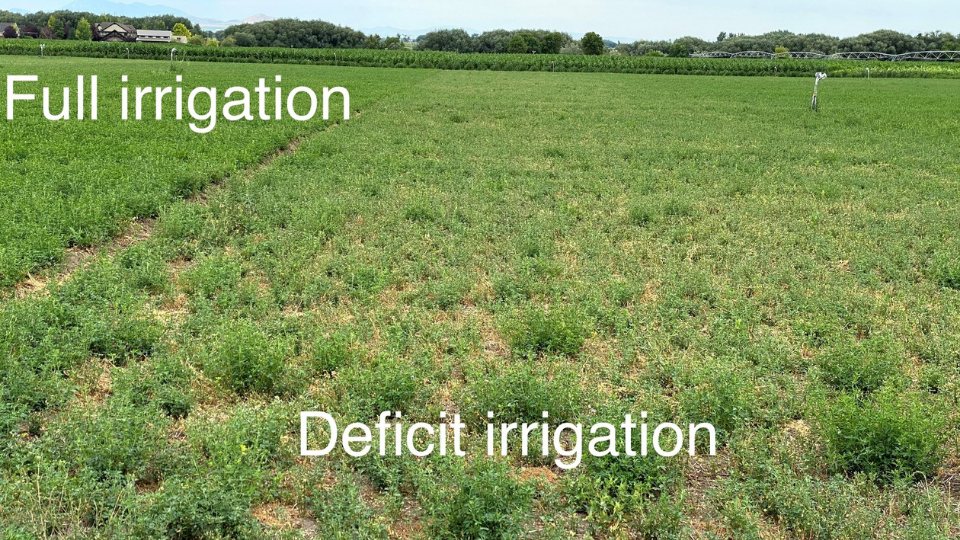
What is deficit irrigation? As the name implies, it can be defined as any irrigation strategy that does not meet the full evapotranspiration (total water use of the crop through evaporation and transpiration) demand of a crop. Partial irrigation is often used interchangeably with deficit irrigation but can also imply irrigating part of the root zone or part of the season. Deficit irrigation is generally not the ideal way to produce forages. It is, however, necessary in some cases due to water shortages, water right restrictions, irrigation system failures, or other related reasons. It might also be a strategic choice in some cases for income through water leasing (“water banks”), or where conservation payments or program incentives support cutting back on irrigation. Whether intentional or not, deficit irrigation will often cause yield, quality, and profit loss. Deficit irrigation strategies with varying effectiveness can be employed in many cases to maximize production and profit. These strategies can include modifying irrigation schedules, concentrating irrigation to critical crop growth stages, reducing rates, terminating irrigation early, or increasing irrigation efficiency in a variety of ways. The crop of interest will also impact best deficit irrigation practices. General considerations for deficit irrigation of the major forage crops alfalfa, small grain forage, corn silage, and teff grass hay will be discussed, followed by recent research results.
Alfalfa
Alfalfa is naturally drought tolerant. Its lengthy root systems can reach over 15 feet deep, providing access to a greater soil volume to scavenge water. Alfalfa also has a unique ability to go into drought-induced dormancy when water is scarce. This feature allows for irrigation to cease at almost any time during the growing season without permanent damage to the stand (Orloff et al., 2015). This approach of ceasing irrigation is usually superior to keeping the alfalfa dull green in color with little to no growth. When irrigation or soil moisture can return to adequate levels, plants break the induced dormancy and resume growth—often returning to full production levels (Lindenmayer et al., 2011). Alfalfa uses water most efficiently during spring growth so irrigation should be targeted earlier rather than later in the season if possible. The first cutting will use about 5 acre-inches of evapotranspiration per ton of alfalfa, compared to about 7 acre-inches for later cuttings (Shewmaker et al., 2013). Plus, the first cutting is usually the highest yielding crop. Deficit irrigation should also be targeted first to the least productive alfalfa land—areas with poor soils, poor irrigation efficiency, poor alfalfa stem density, most weeds, oldest alfalfa, and/or poor varieties. This strategy allows for prioritizing full irrigation on the best land and crop conditions where water use efficiency will be greatest.
Small Grain Forage
Small grains such as wheat, barley, and oats are good annual forage crops during a drought because their water use occurs early in the season, where they can take advantage of precipitation and potential spring runoff. Forage harvest generally occurs in June or July and requires no late water (except for late planting or double cropping scenarios). Small grain forage requires slightly less total irrigation than small grains harvested for grain (Husman and Ottman, 2015), but also have less opportunity for deficit irrigation than grain. Vegetative growth of small grains requires adequate irrigation and is crucial for producing high forage yields.
Silage Corn
Expected water supply and timing of availability should be considered before planting corn to ensure plants can reach maturity. Corn production requires a large financial investment and deficit irrigation strategies are of little value if no grain is produced to enhance corn silage yield and quality. If water availability is uncertain or water may not be available through the whole growing season, producers should consider switching to another cropping option. When planting corn, selecting appropriate hybrids is crucial. For example, shorter day corn matures quicker and can be planted in cases where water may be limited toward the end of the growing season. Deficit irrigation should be targeted to critical growth stages where near full irrigation levels are crucial to yield determination. These include tasseling, silk, and yield formation (Kranz et al., 2008). The best time to water stress corn, if needed, is generally during the vegetative and ripening stages. Since grain is such a vital part of good quality silage corn, strategies for deficit irrigation of silage corn are usually similar to those for grain corn.
Teff
Teff is known as a drought-tolerant crop that thrives on low irrigation levels at frequent intervals. It is planted in early summer (early to mid-June) in most areas, which generally allows for early water (pre-June) to be concentrated on other crops. Early summer planting generally allows for two cuttings, with the first yielding more than the second. Few deficit irrigation studies have been published for teff, but recent research in the Pacific Northwest showed teff required about half the amount of irrigation that alfalfa requires, and that excessive irrigation decreased forage quality (Roseberg et al., 2018). Given the lower irrigation requirement of teff compared to other forages, it may not require deficit irrigation. If deficit irrigation is desired though, the best strategies may include planting in mid-July and only harvesting once and/or increasing irrigation frequency and reducing the rate such that less total water is used than other forages.
Recent Research

A large team of researchers at Utah State University (USU) started testing deficit irrigation strategies for major forage crops in 2019. We evaluated irrigating corn silage at the USU Wellsville Farm near Logan, Utah (Figure 1) with full irrigation (as close to potential evapotranspiration as possible) compared to a 25%, 50%, and a targeted 50% reduction in total irrigation rates for the growing season. This was accomplished by adjusting sprinkler nozzle sizes on a linear irrigation system. The 50% targeted rate applied half the total irrigation for the season, but researchers directed this irrigation toward critical growth stages, such as during corn tasseling or mid-to-late vegetative growth for other forages. This work was repeated and expanded in 2020 to include sites in Logan and Vernal, Utah. Logan included a new alfalfa stand with two cuttings and corn silage, while Vernal included spring 3-way (wheat, oat, and barley) forage, teff, and corn silage.
Alfalfa
Two cuttings of alfalfa were harvested in 2020 in Logan. A total of 13.5 inches of irrigation was applied for both cuttings for the full irrigation rate (Figure 2). The irrigation reductions were achieved by changing nozzle sizes on the linear where alfalfa received 25 or 50% less water each irrigation. When irrigation was reduced by 25%, alfalfa yield was reduced by an average of about 0.75 tons/acre (20%) total for the two cuts. A 50% reduction in irrigation produced 1.2 tons/acre less yield (30% reduction). Results were mixed for the 50% targeted irrigation. It was much worse than the straight 50% reduction for the first cut, but much better in the second cut.
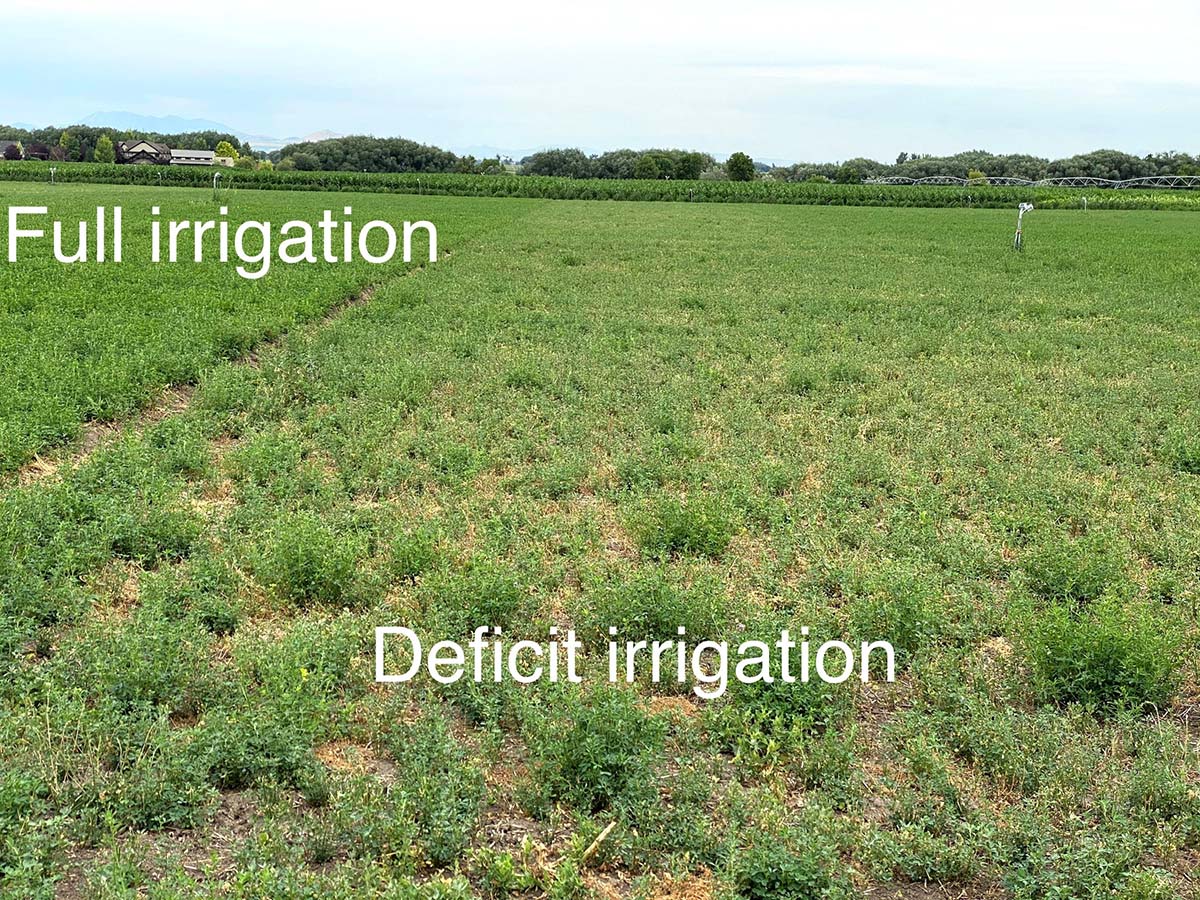
Several forage quality parameters were measured, but only two are presented for simplicity (Figure 3). For the first alfalfa cut, the total digestible nutrients (TDN) and relative feed value (RFV) amounts were consistent across all four irrigation rates and averaged about 70 and 200, respectively. The second cut varied more with the 50% reduction rate having the highest TDN value at about 80 and an RFV of 300. The 25% reduction rate produced slightly lower quality values than the 50% rates but was higher than any of the first cut’s irrigation rates. The full irrigation rate and the targeted 50% reduction both had similar TDN and RFV values with about 70 for the TDN and an RFV of a little over 200.
The alfalfa results show that while the first cut’s yield varied, the quality was consistent across all four of the irrigation rates. The second cut’s yield varied more and had more variation in the quality results. The 50% reduced rate had the lowest yield but had the highest TDN and RFV percentages. The full and 50% targeted reduction had the highest yields but the lowest quality among the four irrigation rates, though they were similar to the first cut’s results. While the reduced irrigation rates result in lower yields, they do not seem to negatively impact the quality of alfalfa, and often result in higher values than the full irrigation rates. The 50% targeted reduction was the exception, with the opposite often being true for the second cut.
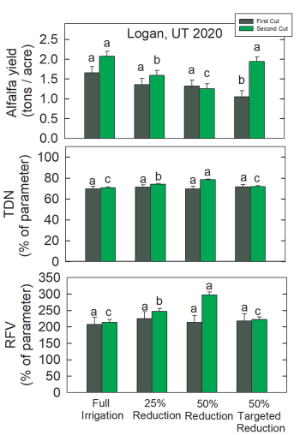
Small grain forage
The full irrigation rate for three-way small grain forage in Vernal was 15 inches. This irrigation rate produced a yield of 4.2 tons/acre. All three deficit irrigation strategies decreased yield by an average of 1.5 tons/acre (35%) (Figure 4). These results show that the two 50% irrigation reductions were equal to the 25% reduction, which signified that the larger reduction of 50% can be made without losing extra forage yield and that targeting the 50% reduction provided no benefit.
While the yield for the three-way varied with the irrigation rate, the TDN and RFV values were not influenced by deficit irrigation. The TDN was about 60 for all levels of irrigation and the RFV was 95–100. Thus, deficit irrigation may have few impacts on small grain forage quality (Figure 4).

Corn silage
Corn silage was evaluated in three growing seasons at two sites (Figure 5). The 25% reduction in irrigation rate always produced the same yield as the full irrigation rate in all three conditions. This means that a small reduction in irrigation all season might be ideal for deficit irrigation. The 50% irrigation reduction was not as consistent. In Logan, only the targeted 50% irrigation reduction decreased yield in 2019 by an average of 2 tons/acre (9% loss). The next year, results were similar for Logan and Vernal, where both 50% reductions in irrigation decreased silage yield by 3–9 tons/acre (7–23% loss). The targeted 50% rate was never superior to the flat 50% reduction.
The 2019 Logan corn results showed that the 50% reduction had the highest TDN and starch values at 70 and 27, respectively. The TDN percentages were similar for full and 25% reduction irrigation rates and were both only slightly lower than the 50% targeted. The 25% irrigation reduction had slightly higher starch values than the full irrigation rate. In this trial, the 50% irrigation reduction produced the same yield and superior quality compared to full irrigation. It was also significantly better than targeting the 50% reduction to critical crop stages.
In 2020, both the Vernal and Logan sites had similar silage corn TDN and starch values across all of the irrigation rates. These results indicate that deficit irrigation had little to no impact on the quality of the corn silage.
Although the 2019 Logan corn data showed a slight variation in quality due to the irrigation rates, both sites in 2020 experienced little to no difference because of these. The 50% reduced rate consistently tested the highest, but there was very little variation in quality for 2020 across any of the irrigation rates. The 25% reduction rate had a similar or better yield and quality values in comparison to the full irrigation rate across all three sites, indicating that this level of reduction could positively impact overall crop value. These results were similar to small grain forage results and show that while the yield may vary due to the water application amounts, the quality is not impacted heavily by these differences.

Teff
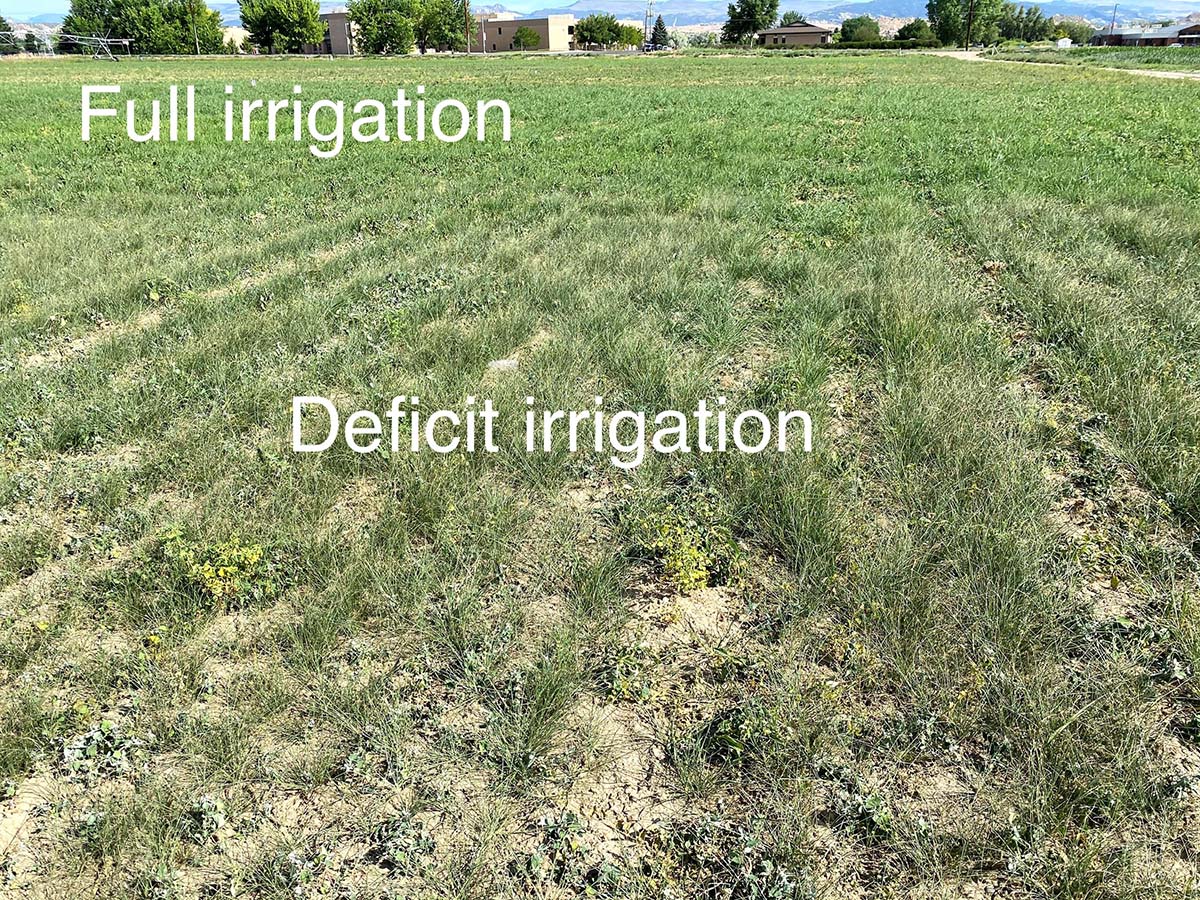
Three teff varieties were evaluated for their response to deficit irrigation in Vernal in 2020 (Figure 6). The full irrigation rate was 12 inches. The 25% reduction in irrigation rate decreased the teff yield of only one variety (Dessie) by 1 ton/acre (27% loss) (Figure 7). The 50% reductions always decreased yield by 17–42% for all three varieties. These results demonstrated that some varieties can handle deficit irrigation better than others.
While all three of the teff varieties experienced the lowest yields at the 50% reduction and 50% targeted reduction rates, these deficit irrigation rates resulted in the highest TDN at 70 and highest RFV at or over 120.
The Corvallis variety had similar forage quality for both the full and 25% reduction rates. The Dessie variety had the highest yield but lowest quality values at the full irrigation rate. The Excalibur variety had similar yields across irrigation rates except for the 50% reduction, which was lower. The TDN and RFV values were higher with the higher reduction rates, with the lowest values occurring at the full irrigation rates. These results show that all three teff varieties had higher TDN and RFV values with deficit irrigation, but also experienced higher losses in yield.
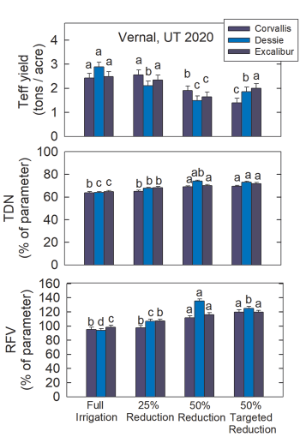
Summary
Deficit and partial irrigation research at Utah State University is ongoing. In 2021, we will continue our work in Logan and Vernal but will also include a third site in Cedar City. We are working on summarizing crop profit, and water use efficiency. Though preliminary, our results so far show that 25% reductions in irrigation of forages result in 0–35% loss in crop yield, depending on the crop. In contrast, deficit irrigation had few and sometimes positive impacts on forage quality. These positive impacts on forage could help offset some of the yield losses incurred by deficit irrigation. The 25% irrigation reductions were usually but not always superior to 50% reductions, and corn handled this reduction better than other crops. We found no advantages of targeting 50% reductions in irrigation rates compared to a flat 50% reduction all season. Both 50% reductions decreased yield by 7–35% across crops. As more data is collected, these recommendations will be refined to further guide best practices for deficit forage irrigation.
References
- Husman, S., & Ottman, M.J. (2015). Irrigation of small grains in Arizona. University of Arizona Extension. az1345. https://cals.arizona.edu/forageandgrain/sites/cals.arizona.edu.forageandgrain/files/az1345-2015.pdf
- Kranz, W.L., Irmak, S., Van Donk, S.M., Yonts, C.D., & Martin, D.L. (2008). Irrigation management for corn. University of Nebraska Extension. G1850. https://extensionpublications.unl.edu/assets/pdf/g1850.pdf
- Lindenmayer, R.B., Hansen, N.C., Brummer, J., & Pritchett, J.G. (2011). Deficit irrigation of alfalfa for water-savings in the Great Plains and Intermountain West: A review and analysis of the literature. Agronomy Journal, 103, 45–50. https://doi.org/10.2134/agronj2010.0224
- Orloff, S., Putnam, D., & Bali, K. (2015). Drought strategies for alfalfa. University of California Extension. ANR Publication 8522. https://anrcatalog.ucanr.edu/pdf/8522.pdf
- Roseberg, R., Norberg, S., & Charlton, B. (2018). Teff grass for forage: Nitrogen and irrigation requirements. A Pacific Northwest Extension Publication. PNW 709. https://catalog.extension.oregonstate.edu/sites/catalog/files/project/pdf/pnw709.pdf
- Shewmaker, G.E., Allen, R.G., & Neibling, H. (2013). Alfalfa irrigation and drought. University of Idaho Extension. https://www.uidaho.edu/-/media/UIdaho-Responsive/Files/cals/centers/Kimberly/forage/Alfalfa-Irrigation-Facts-2013.pdf
All photographs were taken by Matt Yost.
Acknowledgements
The authors would like to thank the Foundation for Food and Agriculture Research (FFAR), Western Sustainable Agriculture Research and Education (SARE), Central Utah Water Conservancy District (CUWCD), the Utah Agricultural Experiment Station (UAES), and Utah State University Extension for funding to complete this research.
Published April 2021
Utah State University Extension
Peer-reviewed fact sheet
Authors
Matt Yost, Tina Sullivan, Niel Allen, Boyd Kitchen, Megan Baker, and Earl Creech





